All-Day Freshwater Harvesting Using Solar Auto-Tracking Assisted Selective Solar Absorption and Radiative Cooling
Highlights
- An all-weather freshwater collection device with solar auto-tracking assisted photothermal–radiative cooling was developed;
- A selective solar absorber was prepared with an average solar absorptivity of 0.91 and mid-IR emissivity of 0.12;
- The radiative cooling film enables daytime (7.62 °C) and nighttime (7.03 °C) cooling for water condensation;
- The solar auto-tracking freshwater system collects 0.79 kg m−2 in 24 h, 23.4% more than the non-tracking system.
Abstract
1. Introduction
2. System Summarization
2.1. Preparation of Solar Collector Module
2.2. Preparation of the Solar Auto-Tracking System
2.3. Preparation of the Radiative Cooling Module
3. Experimental Section
3.1. Performance Testing of the Evaporation and Condensation Side
3.2. All-Weather Freshwater Collection Experiments
4. Results and Discussion
4.1. Evaporation Side Performance Evaluation
4.2. Condensation Side Performance Evaluation
4.3. Freshwater Collection Efficiency and Discussion
5. Conclusions
Supplementary Materials
Author Contributions
Funding
Institutional Review Board Statement
Informed Consent Statement
Data Availability Statement
Conflicts of Interest
References
- Grison, C.; Koop, S.; Eisenreich, S.; Hofman, J.; Chang, I.S.; Wu, J.; Savic, D.; van Leeuwen, K. Integrated Water Resources Management in Cities in the World: Global Challenges. Water Resour. Manag. 2023, 37, 2787–2803. [Google Scholar] [CrossRef]
- Mekonnen, M.M.; Hoekstra, A.Y. Four billion people facing severe water scarcity. Sci. Adv. 2016, 2, e1500323. [Google Scholar] [CrossRef] [PubMed]
- Zhong, R.; Chen, A.; Zhao, D.; Mao, G.; Zhao, X.; Huang, H.; Liu, J. Impact of international trade on water scarcity: An assessment by improving the Falkenmark indicator. J. Clean. Prod. 2023, 385, 135740. [Google Scholar] [CrossRef]
- Kalogirou, S. Seawater desalination using renewable energy sources. Prog. Energy Combust. Sci. 2005, 31, 242–281. [Google Scholar] [CrossRef]
- Green, P.A.; Voeroesmarty, C.J.; Harrison, I.; Farrell, T.; Saenz, L.; Fekete, B.M. Freshwater ecosystem services supporting humans: Pivoting from water crisis to water solutions. Glob. Environ. Change-Hum. Policy Dimens. 2015, 34, 108–118. [Google Scholar] [CrossRef]
- Nishad, S.; Elmoughni, H.M.; Krupa, I. Advancements in radiative cooling structures for atmospheric water harvesting: A comprehensive review. Appl. Energy 2025, 377, 124576. [Google Scholar] [CrossRef]
- Gude, V.G. Desalination and water reuse to address global water scarcity. Rev. Environ. Sci. Bio-Technol. 2017, 16, 591–609. [Google Scholar] [CrossRef]
- Lasage, R.; Verburg, P.H. Evaluation of small scale water harvesting techniques for semi-arid environments. J. Arid Environ. 2015, 118, 48–57. [Google Scholar] [CrossRef]
- An, K.J.; Lam, Y.F.; Hao, S.; Morakinyo, T.E.; Furumai, H. Multi-purpose rainwater harvesting for water resource recovery and the cooling effect. Water Res. 2015, 86, 116–121. [Google Scholar] [CrossRef]
- Xi, Z.; Li, S.; Yu, L.; Yan, H.; Chen, M. All-Day Freshwater Harvesting by Selective Solar Absorption and Radiative Cooling. ACS Appl. Mater. Interfaces 2022, 14, 26255–26263. [Google Scholar] [CrossRef]
- Chen, M.; Wang, J.; Li, S.; Chen, W.; Yan, H.; Sheldon, B.W.; Li, Q.; Shi, C. An All-Passive and Macropatterned Architecture Design for Water Harvesting. Nano Lett. 2024, 24, 16143–16150. [Google Scholar] [CrossRef] [PubMed]
- Xiang, T.; Xie, S.; Chen, G.; Zhang, C.; Guo, Z. Recent advances in atmospheric water harvesting technology and its development. Mater. Horiz. 2025, 12, 1084–1105. [Google Scholar] [CrossRef] [PubMed]
- Jarimi, H.; Powell, R.; Riffat, S. Review of sustainable methods for atmospheric water harvesting. Int. J. Low-Carbon Technol. 2020, 15, 253–276. [Google Scholar] [CrossRef]
- Thavalengal, M.S.; Jamil, M.A.; Mehroz, M.; Xu, B.B.; Yaqoob, H.; Sultan, M.; Imtiaz, N.; Shahzad, M.W. Progress and Prospects of Air Water Harvesting System for Remote Areas: A Comprehensive Review. Energies 2023, 16, 2686. [Google Scholar] [CrossRef]
- Wang, M.; Liu, E.; Jin, T.; Zafar, S.-u.; Mei, X.; Fauconnier, M.-L.; De Clerck, C. Towards a better understanding of atmospheric water harvesting (AWH) technology. Water Res. 2024, 250, 121052. [Google Scholar] [CrossRef]
- Sathyamurthy, R.; El-Agouz, S.A.; Nagarajan, P.K.; Subramani, J.; Arunkumar, T.; Mageshbabu, D.; Madhu, B.; Bharathwaaj, R.; Prakash, N. A Review of integrating solar collectors to solar still. Renew. Sustain. Energy Rev. 2017, 77, 1069–1097. [Google Scholar] [CrossRef]
- Cervantes-Rendon, E.; Ibarra-Bahena, J.; Cervera-Gomez, L.E.; Romero, R.J.; Cerezo, J.; Rodriguez-Martinez, A.; Dehesa-Carrasco, U. Rural Application of a Low-Pressure Reverse Osmosis Desalination System Powered by Solar-Photovoltaic Energy for Mexican Arid Zones. Sustainability 2022, 14, 10958. [Google Scholar] [CrossRef]
- Lyu, M.; Lin, J.; Shi, D. Solar Desalination via Multilayers of Transparent Photothermal Fe3O4@ Cu2–xS Thin Films. Energy Technol. 2021, 9, 2100590. [Google Scholar] [CrossRef]
- Zakaria, M.; Sharaky, A.M.; Al-Sherbini, A.-S.; Bassyouni, M.; Rezakazemi, M.; Elhenawy, Y. Water Desalination Using Solar Thermal Collectors Enhanced by Nanofluids. Chem. Eng. Technol. 2022, 45, 15–25. [Google Scholar] [CrossRef]
- Xu, Y.-X.; Han, J.-C.; Tang, Q.; Gu, L.; Wu, Q.-Y. A leaf-like photothermal evaporator with enhanced thermal conduction in reversed solar-driven desalination for efficient freshwater harvest. Sep. Purif. Technol. 2025, 354, 129453. [Google Scholar] [CrossRef]
- Tian, Y.; Liu, X.; Caratenuto, A.; Li, J.; Zhou, S.; Ran, R.; Chen, F.; Wang, Z.; Wan, K.-t.; Xiao, G.; et al. A new strategy towards spectral selectivity: Selective leaching alloy to achieve selective plasmonic solar absorption and infrared suppression. Nano Energy 2022, 92, 106717. [Google Scholar] [CrossRef]
- Chen, M.; Li, S.; Pang, D.; Yan, H. Selective absorber and emitter boost water evaporation and condensation toward water collection. Mater. Today Energy 2022, 28, 101072. [Google Scholar] [CrossRef]
- Alqaed, S.; Mustafa, J.; Almehmadi, F.A.; Jamil, B. Estimation of ideal tilt angle for solar-PV panel surfaces facing south: A case study for Najran City, Saudi Arabia. J. Therm. Anal. Calorim. 2023, 148, 8641–8654. [Google Scholar] [CrossRef]
- Ou, Y.; Ji, H.; Wang, Y.; Liu, B.; Chen, Y.; Tao, J.; Huang, Y.; Wang, J. Photothermal synergistic modulation of patterned VO2-Based composite films for smart windows. Sol. Energy 2024, 279, 112808. [Google Scholar] [CrossRef]
- Liu, Y.; Tian, J.; Xu, L.; Wang, Y.; Fei, X.; Li, Y. Multilayer graphite nano-sheet composite hydrogel for solar desalination systems with floatability and recyclability. New J. Chem. 2020, 44, 20181–20191. [Google Scholar] [CrossRef]
- Kazemian, A.; Ma, T.; Hongxing, Y. Evaluation of various collector configurations for a photovoltaic thermal system to achieve high performance, low cost, and lightweight. Appl. Energy 2024, 357, 122422. [Google Scholar] [CrossRef]
- Wang, Y.; Ji, H.; Chen, Y.; Liu, B.; Huang, J.; Lu, M.; Ou, Y.; Zhao, Y.; Tao, J.; Huang, Y.; et al. Artificially adjustable radiative cooling device with environmental adaptability. Ceram. Int. 2023, 49, 40297–40304. [Google Scholar] [CrossRef]
- Zhao, Y.; Ji, H.; Ou, Y.; Wang, Y.; Chen, Y.; Tao, J.; Liu, B.; Lu, M.; Huang, Y.; Wang, J. Novel sunlight-driven Cu7S4/VO2 composite films for smart windows. J. Mater. Chem. C 2024, 12, 2534–2543. [Google Scholar] [CrossRef]
- Wang, Y.; Ji, H.; Liu, B.; Tang, P.; Chen, Y.; Huang, J.; Ou, Y.; Tao, J. Radiative cooling: Structure design and application. J. Mater. Chem. A 2024, 12, 9962–9978. [Google Scholar] [CrossRef]
- Yang, X.; Wang, S.; Zhang, D.; Yu, J. Theoretical investigation of two ideal radiative cooling materials and radiative sky water-cooling module with ideal selective radiative materials. Energy Build. 2024, 323, 114768. [Google Scholar] [CrossRef]
- Qi, G.; Tan, X.; Jiao, Y.; Dai, Q.; Qiao, Y.; Yang, X.; Wang, Y.; Chen, S.; Shi, C.; Yan, K.; et al. A scalable and aging-resistant film for radiative cooling. Appl. Therm. Eng. 2024, 257, 124310. [Google Scholar] [CrossRef]
- Wang, C.; Chen, H.; Wang, F. Passive daytime radiative cooling materials toward real-world applications. Prog. Mater. Sci. 2024, 144, 101276. [Google Scholar] [CrossRef]
- Shao, H.; Niu, J.; Zhang, Y.; Wang, H.; Lu, C.; Ma, Y.; Chen, H.; Li, S.; Qian, H. Mass-Producible Transparent Flexible Passive-Cooling Film. ACS Appl. Mater. Interfaces 2024, 16, 57246–57252. [Google Scholar] [CrossRef]
- Lv, S.; Guo, Y.; Lv, W.; Wang, Z.; Pan, Y.; Ren, J. Modeling and performance evaluation of radiative cooling-assisted interfacial evaporation for all-day freshwater harvesting. Desalination 2025, 593, 118241. [Google Scholar] [CrossRef]
- Huang, Y.; Li, Q.; Chen, Z.; Chen, M. Sorbent-coupled radiative cooling and solar heating to improve atmospheric water harvesting. J. Colloid Interface Sci. 2024, 655, 527–534. [Google Scholar] [CrossRef]
- Ramful, R.; Sowaruth, N. Low-cost solar tracker to maximize the capture of solar energy in tropical countries. Energy Rep. 2022, 8, 295–302. [Google Scholar] [CrossRef]
- Wu, C.-H.; Wang, H.-C.; Chang, H.-Y. Dual-axis solar tracker with satellite compass and inclinometer for automatic positioning and tracking. Energy Sustain. Dev. 2022, 66, 308–318. [Google Scholar] [CrossRef]
- Liu, X.; Beysens, D.; Bourouina, T. Water Harvesting from Air: Current Passive Approaches and Outlook. ACS Mater. Lett. 2022, 4, 1003–1024. [Google Scholar] [CrossRef]
- Xu, J.; Huo, X.; Yan, T.; Wang, P.; Bai, Z.; Chao, J.; Yang, R.; Wang, R.; Li, T. All-in-one hybrid atmospheric water harvesting for all-day water production by natural sunlight and radiative cooling. Energy Environ. Sci. 2024, 17, 4988–5001. [Google Scholar] [CrossRef]
- Lyu, T.; Han, Y.; Chen, Z.; Fan, X.; Tian, Y. Hydrogels and hydrogel derivatives for atmospheric water harvesting. Mater. Today Sustain. 2024, 25, 100693. [Google Scholar] [CrossRef]
- Arunkumar, T.; Parbat, D.; Lee, S.J. Comprehensive review of advanced desalination technologies for solar-powered all-day, all-weather freshwater harvesting systems. Renew. Sustain. Energy Rev. 2024, 199, 114505. [Google Scholar] [CrossRef]
- Mandal, J.; Wang, D.; Overvig, A.C.; Shi, N.N.; Paley, D.; Zangiabadi, A.; Cheng, Q.; Barmak, K.; Yu, N.; Yang, Y. Scalable, “Dip-and-Dry” Fabrication of a Wide-Angle Plasmonic Selective Absorber for High-Efficiency Solar-Thermal Energy Conversion. Adv. Mater. 2017, 29, 1702156. [Google Scholar] [CrossRef]
- Yin, X.; Yang, R.; Tan, G.; Fan, S. Terrestrial radiative cooling: Using the cold universe as a renewable and sustainable energy source. Science 2020, 370, 786–791. [Google Scholar] [CrossRef]
- Tian, Y.; Jiang, Y.; Zhu, R.; Yang, X.; Wu, D.; Wang, X.; Yu, J.; Li, Y.; Gao, T.; Li, F. Solar-Driven Multistage Device Integrating Dropwise Condensation and Guided Water Transport for Efficient Freshwater and Salt Collection. Environ. Sci. Technol. 2024, 58, 7335–7345. [Google Scholar] [CrossRef]
- Xu, J.; Zhang, J.; Fu, B.; Song, C.; Shang, W.; Tao, P.; Deng, T. All-Day Freshwater Harvesting through Combined Solar-Driven Interfacial Desalination and Passive Radiative Cooling. ACS Appl. Mater. Interfaces 2020, 12, 47612–47622. [Google Scholar] [CrossRef]
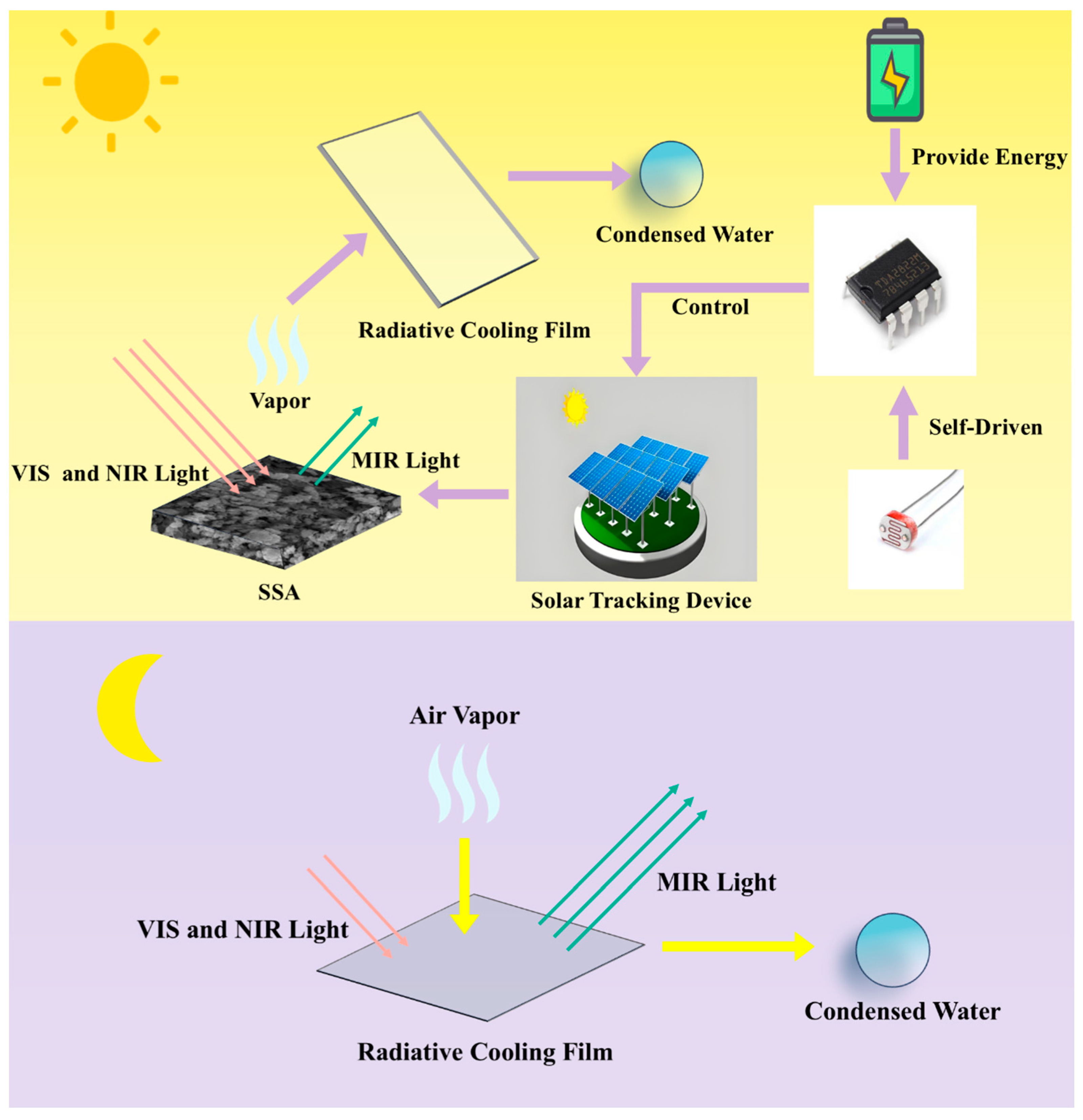
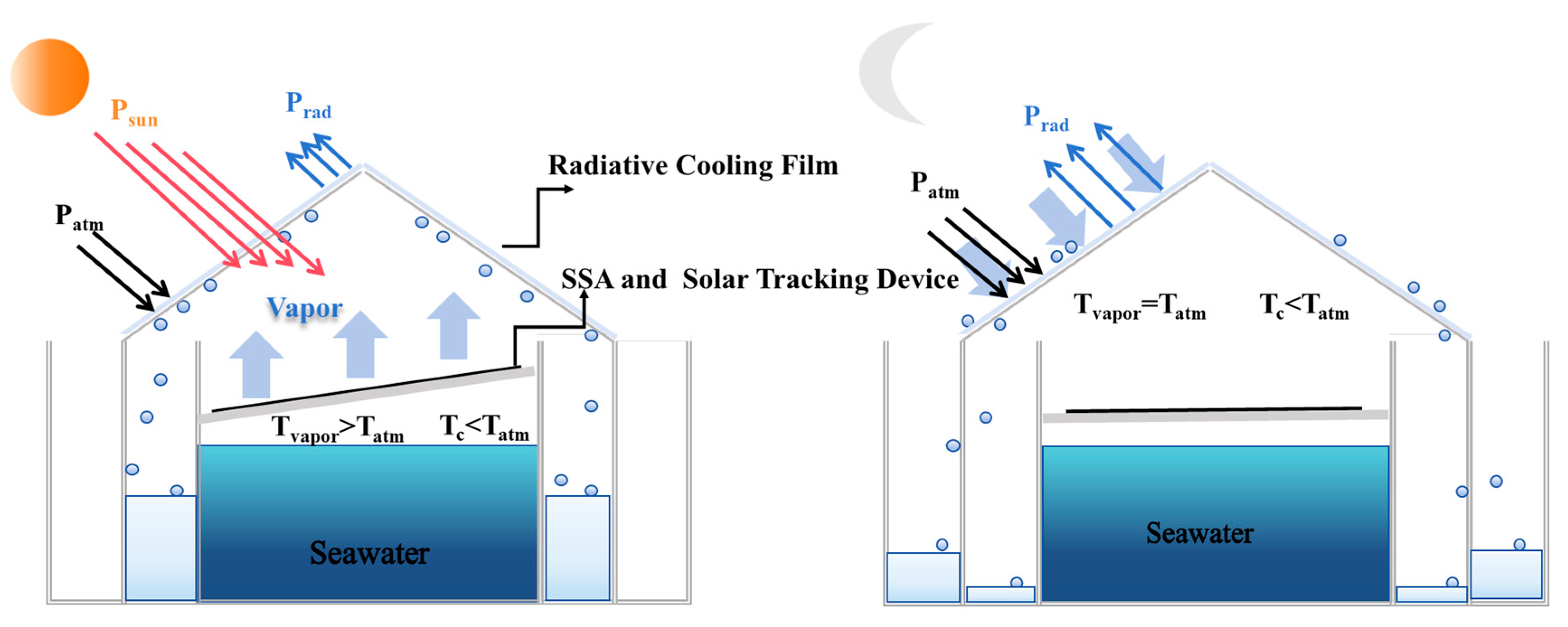
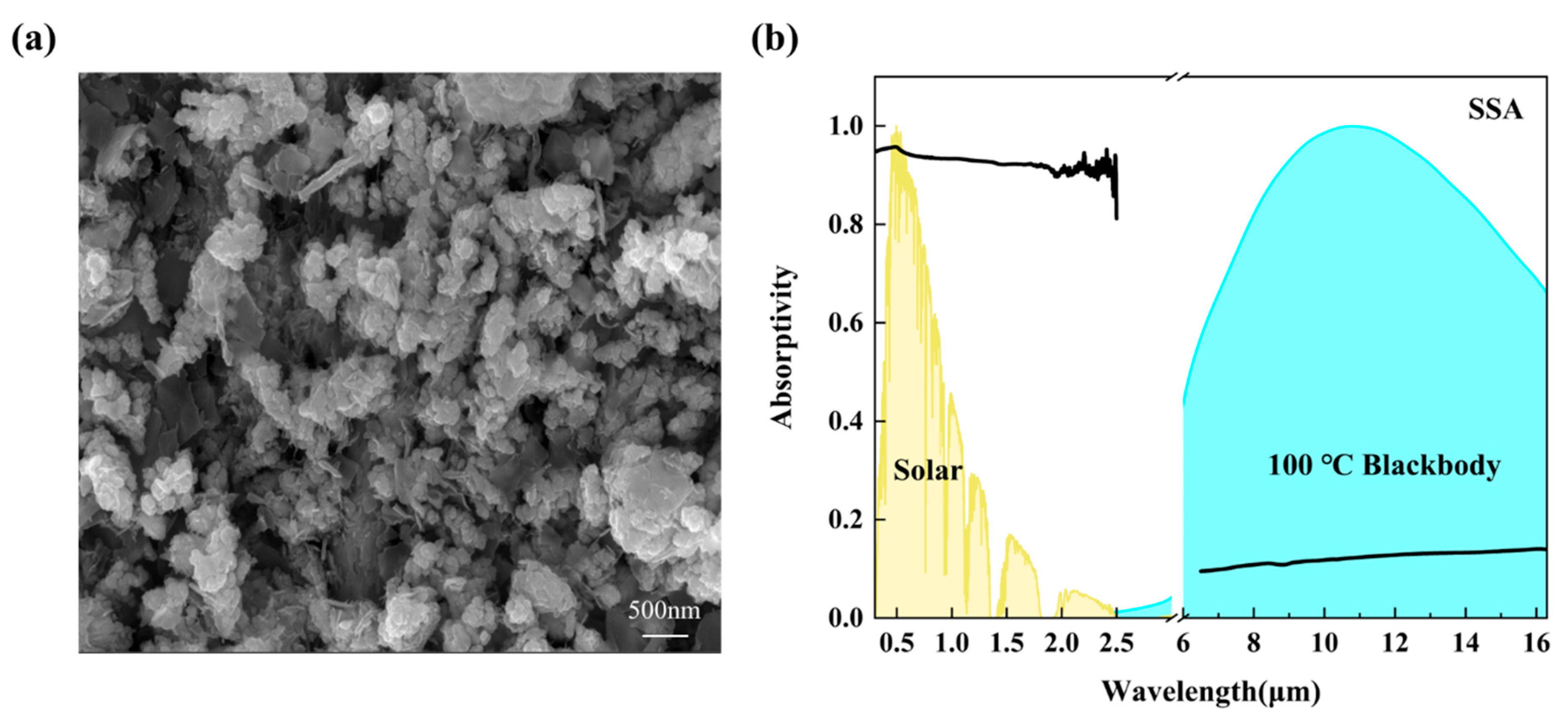
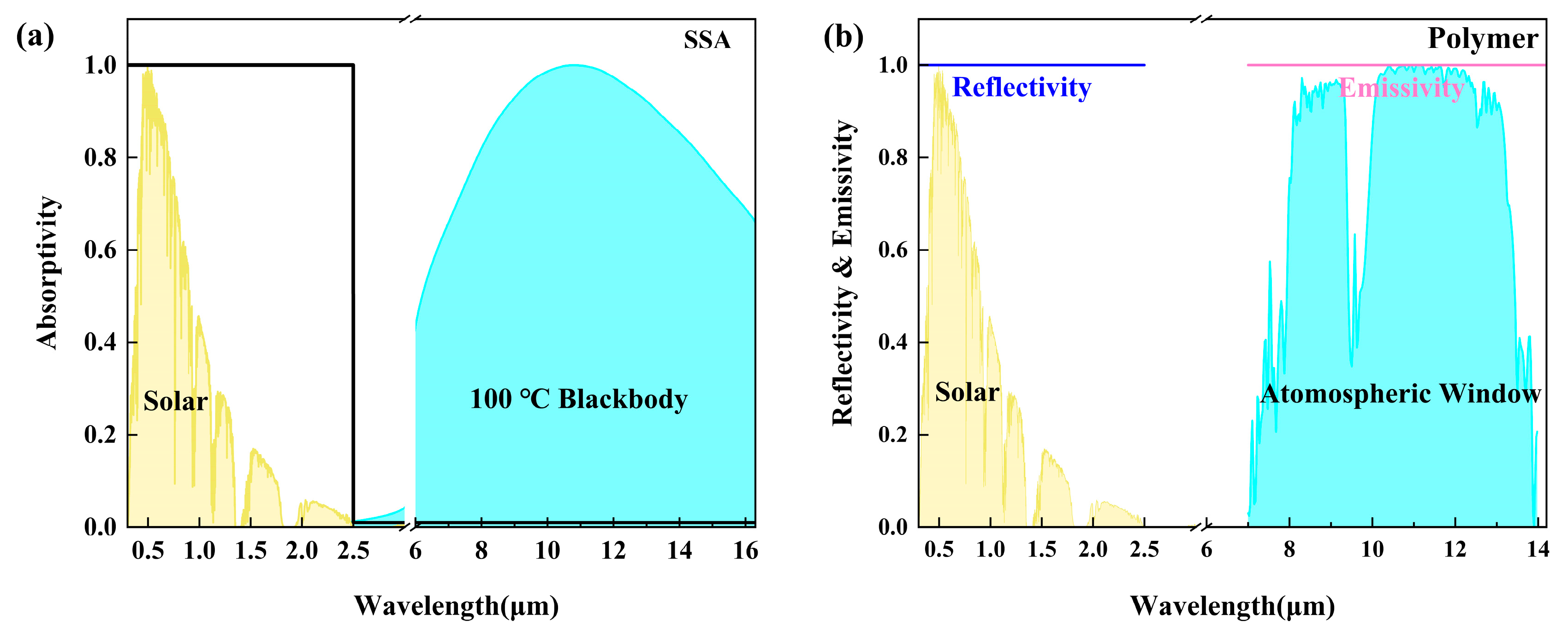

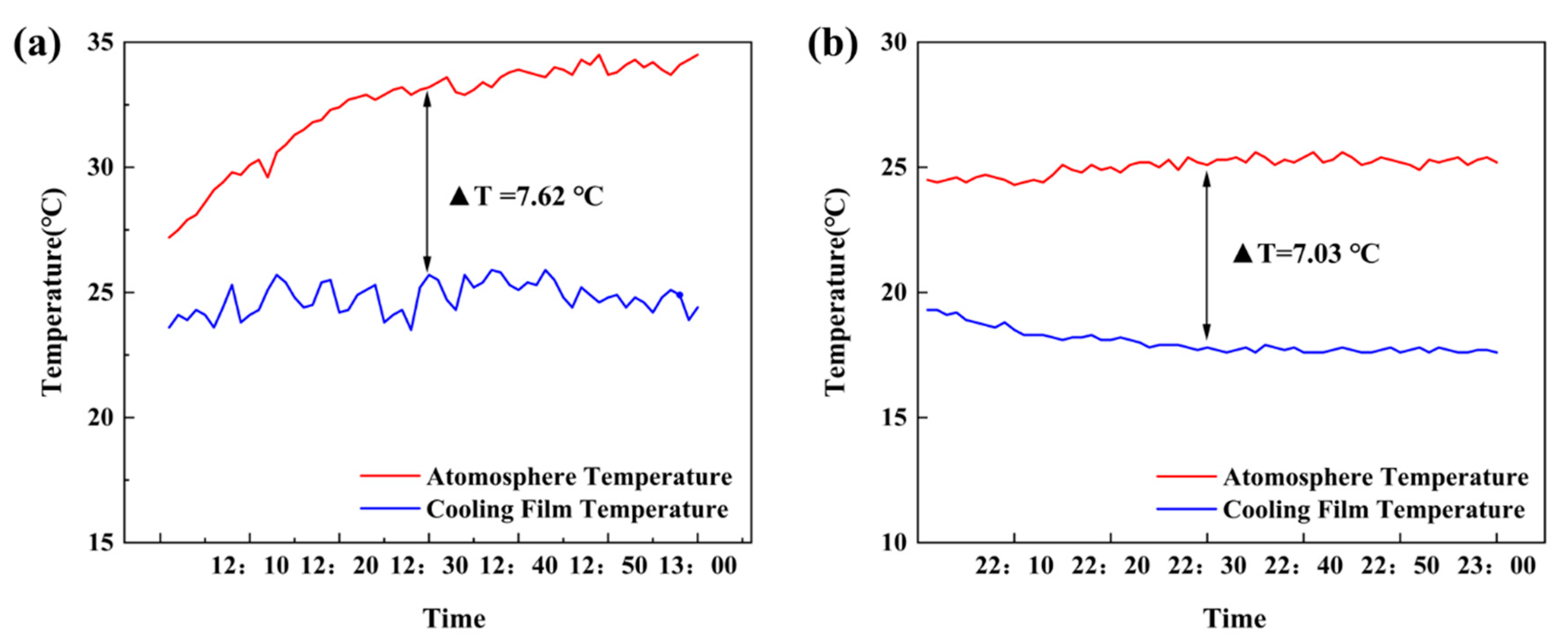

Disclaimer/Publisher’s Note: The statements, opinions and data contained in all publications are solely those of the individual author(s) and contributor(s) and not of MDPI and/or the editor(s). MDPI and/or the editor(s) disclaim responsibility for any injury to people or property resulting from any ideas, methods, instructions or products referred to in the content. |
© 2025 by the authors. Licensee MDPI, Basel, Switzerland. This article is an open access article distributed under the terms and conditions of the Creative Commons Attribution (CC BY) license (https://creativecommons.org/licenses/by/4.0/).
Share and Cite
Luo, J.; Ji, H.; Luo, R.; Zheng, X.; Xiao, T. All-Day Freshwater Harvesting Using Solar Auto-Tracking Assisted Selective Solar Absorption and Radiative Cooling. Materials 2025, 18, 2967. https://doi.org/10.3390/ma18132967
Luo J, Ji H, Luo R, Zheng X, Xiao T. All-Day Freshwater Harvesting Using Solar Auto-Tracking Assisted Selective Solar Absorption and Radiative Cooling. Materials. 2025; 18(13):2967. https://doi.org/10.3390/ma18132967
Chicago/Turabian StyleLuo, Jing, Haining Ji, Runteng Luo, Xiangkai Zheng, and Tianjian Xiao. 2025. "All-Day Freshwater Harvesting Using Solar Auto-Tracking Assisted Selective Solar Absorption and Radiative Cooling" Materials 18, no. 13: 2967. https://doi.org/10.3390/ma18132967
APA StyleLuo, J., Ji, H., Luo, R., Zheng, X., & Xiao, T. (2025). All-Day Freshwater Harvesting Using Solar Auto-Tracking Assisted Selective Solar Absorption and Radiative Cooling. Materials, 18(13), 2967. https://doi.org/10.3390/ma18132967






